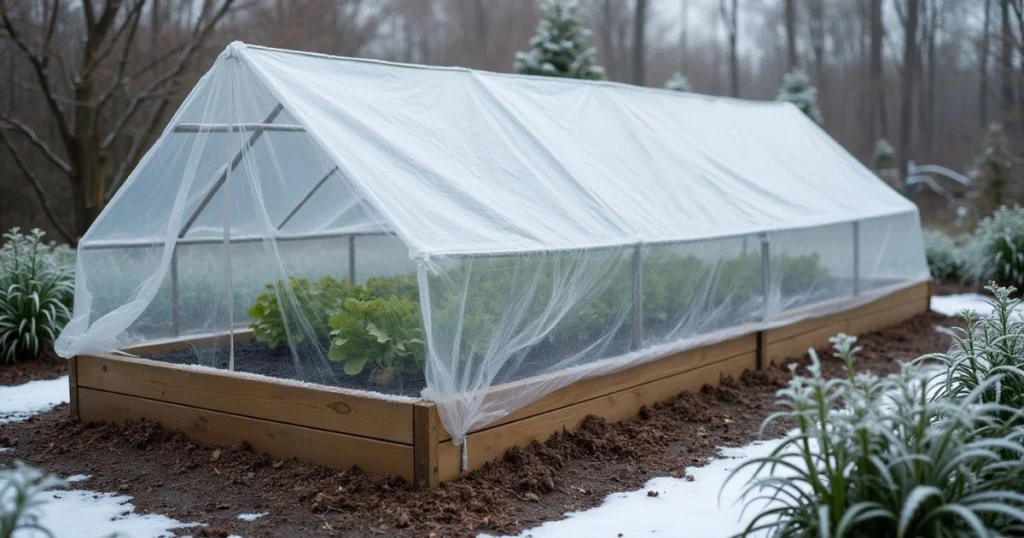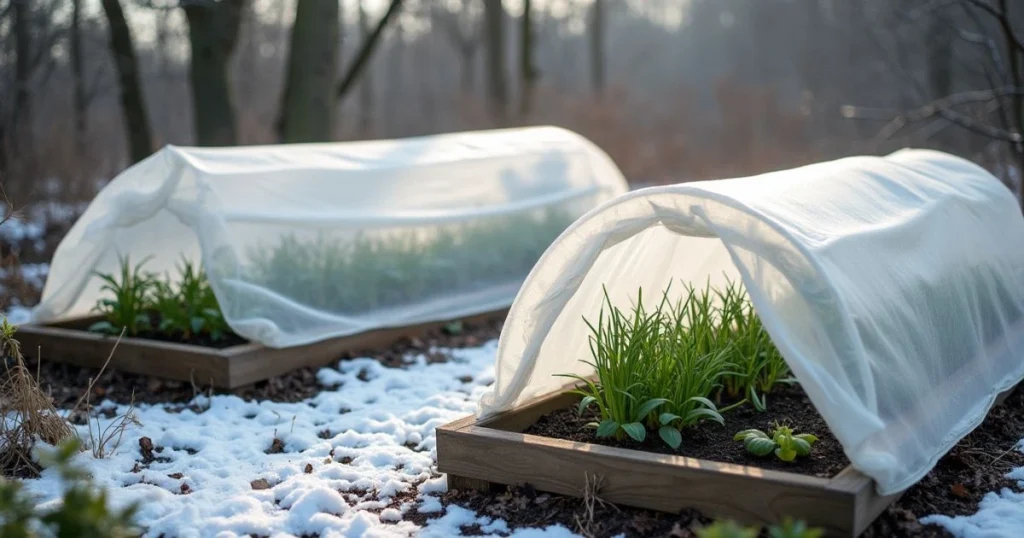As winter approaches, many gardeners become increasingly concerned about the impact of frost and freezing temperatures on their cherished raised bed gardens. If you’ve invested time and effort into nurturing your plants and enriching your soil, it’s crucial to protect that investment. Covering a raised bed garden is essential for preserving soil quality, shielding plants from frost, and extending your growing season. This comprehensive guide will provide you with six essential tips for effectively covering a raised bed garden during the winter months, ensuring your garden remains healthy and vibrant when spring arrives.
Table of Contents
Why Winter Cover is Essential for Your Raised Bed Garden
Covering a raised bed garden is not merely a precaution; it’s a proactive strategy that can significantly affect the health of your plants and soil. Here’s why covering your raised bed garden is essential during the winter:
- Protecting Soil Quality and Nutrients
Winter’s cold can quickly deplete nutrients from your soil, leading to compacted and less fertile ground. By covering a raised bed garden, you help retain the soil’s structure and prevent nutrient leaching. This covering ensures that beneficial microorganisms remain active, creating a stable environment for your plants and allowing them to thrive. - Shielding Plants from Frost and Snow
Frost can severely damage or kill unprotected plants, making it critical to have an effective covering in place. Covering a raised bed garden acts as a barrier against frost, reducing exposure and helping your plants survive the harsh winter conditions. - Extending the Growing Season
With the right protective cover, you can extend your garden’s productivity well into winter and start your growing season earlier in spring. Certain types of covers allow you to keep plants growing through colder months, maximizing your raised bed garden‘s potential.
Types of Covers for Raised Bed Gardens
When it comes to covering a raised bed garden, several options are available, each with unique benefits suited for different gardening needs. Here’s a closer look at the most common types of covers:
1. Frost Blankets for Simple, Effective Protection

Frost blankets are an excellent choice for gardeners seeking a straightforward, effective solution. These covers are affordable and easy to apply, making them ideal for those new to gardening. Frost blankets provide a protective layer against cold air and wind, helping to keep plants safe from light frost and temperatures down to about 20°F (-6°C).
- Best For: Short-term winter coverage in moderate climates.
- Application Tip: Lay the blanket over your raised bed garden and secure the edges with garden staples or bricks to ensure it stays in place during windy weather.
2. Polyethylene Film for a Greenhouse Effect

If you live in a colder region, polyethylene film can be an excellent option for covering a raised bed garden. This material creates a mini-greenhouse effect, trapping warmth and moisture. However, it’s essential to monitor the humidity levels under the film to avoid mold growth.
- Best For: Cold climates requiring long-term protection.
- Application Tip: Ensure proper ventilation by leaving small openings to allow excess moisture to escape, reducing the risk of mold.
3. Row Covers for Versatile Coverage

Row covers are lightweight, breathable fabrics that allow sunlight and air to reach your plants while providing protection from frost. They’re especially useful for gardeners looking to extend the growing season for certain vegetables, as they offer moderate insulation.
- Best For: Cooler climates and for extending the growing season.
- Application Tip: Use hoops or stakes to lift the row cover off your plants, creating a low tunnel effect that prevents the cover from touching foliage directly.
4. DIY Cold Frames for Extra Winter Protection

For those who enjoy DIY projects, building a cold frame can provide excellent winter protection for your raised bed garden. A cold frame offers a controlled environment, protecting plants from extreme temperatures while allowing sunlight in.
- Best For: Harsh winter climates and for dedicated gardeners looking for long-term solutions.
- Application Tip: Construct your cold frame with materials like old windows or Plexiglas to create a sturdy, insulated structure over your raised bed garden.
How to Choose the Right Cover for Your Garden
Selecting the right cover for your raised bed garden is crucial for ensuring winter protection. Here are some tips to help you choose the best cover:
- Assess Your Local Climate
Understanding your local climate is key to selecting the right cover. If you experience mild winters, a simple frost blanket may suffice. However, if you face severe cold, consider investing in a cold frame or polyethylene film. - Consider the Types of Plants in Your Bed
Different plants have varying levels of cold tolerance. For example, hardy vegetables like kale and spinach can withstand lower temperatures with minimal protection, while more delicate plants may require additional insulation through row covers or cold frames. - Evaluate Your Budget and Maintenance Preferences
Your gardening budget will also influence your choice of cover. Frost blankets and polyethylene films are cost-effective, while DIY cold frames may require more investment but can offer better long-term protection.
How to Properly Install and Secure Your Winter Cover
Once you’ve chosen the appropriate cover for your raised bed garden, it’s time to install and secure it correctly. Here’s how:
- Start with a Clean Bed
Before covering your raised bed garden, clear away any dead plants, weeds, and debris. A clean bed helps prevent pests and diseases from overwintering. Consider adding a layer of compost or mulch before applying your cover to enrich the soil and prepare it for spring. - Secure the Edges
To prevent your cover from being blown away by winter winds, it’s essential to anchor it properly. Use garden staples, stones, or bricks to secure the edges of the cover firmly. This will help keep cold air from entering and ensure that your plants remain protected. - Monitor Conditions Regularly
Regular inspections are vital to maintaining the health of your raised bed garden. Check your covered garden bed every week or two to ensure that the cover remains intact and that moisture levels are appropriate. Adjust the cover as needed to accommodate weather changes.
Best Practices for Maintaining Raised Bed Covers Throughout Winter
To get the most out of your winter cover, it’s essential to follow best practices. Here are some tips for maintaining your covers during the cold months:
- Inspect for Wear and Tear
Snow and ice can put a strain on your covers, so be vigilant. After heavy snowfall, check for any signs of damage and repair any rips to maintain insulation. - Add Insulating Layers for Extreme Cold
If you expect particularly harsh winter weather, consider adding extra layers under your cover. Materials like straw or mulch can provide additional insulation and keep your plants warmer. - Adjust Based on Weather
Keep an eye on the weather forecast, especially during warm spells. If you experience unseasonably warm days, temporarily remove or adjust your cover to prevent overheating and moisture buildup, which can lead to mold growth.
What to Do in Spring to Prepare Your Bed for Planting
As winter transitions to spring, it’s time to prepare your raised bed garden for a new growing season. Follow these steps to ensure a smooth transition:
- Gradually Remove the Cover
Start by gradually removing the cover from your raised bed garden. This helps acclimate your plants to outdoor conditions. Begin by lifting the cover for short periods each day, increasing the time as the temperatures rise. - Refresh the Soil
Once the cover is removed, it’s essential to refresh your soil. Add a layer of compost or organic fertilizer to replenish nutrients lost during winter. Turn the soil lightly to incorporate the amendments and prepare for planting.
FAQ Section
Can I leave my raised bed uncovered during winter?
While it is possible to leave your raised bed garden uncovered, doing so poses risks to soil quality and plant health. Covering a raised bed garden helps prevent nutrient loss and protects against frost damage.
What is the best cover for extremely cold climates?
For extremely cold climates, investing in a cold frame or using heavy-duty polyethylene film is highly recommended, as these options provide robust insulation and protection for your raised bed garden.
How often should I check under the cover?
Aim to check your covered raised bed garden every 1–2 weeks. This will help you monitor temperature, moisture levels, and signs of pests or disease.
Covering a raised bed garden is essential for protecting your hard work during the winter months. By implementing these six must-have tips, you’ll be equipped to maintain soil health, shield your plants from harsh weather, and prepare for a thriving spring. Whether you opt for frost blankets, row covers, or DIY cold frames, ensuring your raised bed garden is properly covered will yield rewards in the growing season ahead.
Ready to protect your raised bed garden this winter? Choose the right cover and apply these essential tips today to set your garden up for success. Share your winter gardening experiences, and let’s keep the conversation going!


